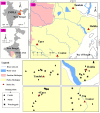Integrated zooplankton and heavy metal analysis as indicators of pollution threats in freshwater ecosystems of West Bengal
- PMID: 41028445
- PMCID: PMC12485149
- DOI: 10.1038/s41598-025-99260-w
Integrated zooplankton and heavy metal analysis as indicators of pollution threats in freshwater ecosystems of West Bengal
Abstract
Freshwater bodies are a vital resource for humans, yet they are threatened by numerous factors, many of which remain unidentified. In this study, we assessed the concentrations of seven heavy metals (HMs) in forty-eight water samples and analyzed their correlation with zooplankton populations and human health risks at four sub-divisional sites in West Bengal, India. Sampling was conducted throughout the year. We used indices based on HMs and zooplankton to evaluate human health risks. The results revealed that the total taxonomic richness of zooplankton (Rotifera, Copepoda, and Branchiopods) was 72 species, with Rotifera richness 25, Copepoda 37, and Branchiopods 10 species. These results demonstrated a negative correlation between zooplankton abundance and HMs concentration, highlighting zooplankton's potential as significant indicator species. Pearson's correlation analysis revealed a significant relationship between HMs concentration and zooplankton abundance (P < 0.05). Among the four sub-divisional areas studied, Haldia exhibited the highest level of heavy metal pollution, with 40.47% of heavy metals posing potential health risks (HQ > 1) to both adults and children due to industrial effluent compared to the other study sites. Overall, the Metal Index and Nemerow Pollution Index indicated that 83.34% and 97.92% of water samples, respectively, were contaminated by heavy metals. Among the heavy metals, Nickel (Ni) and Zinc (Zn) were identified as having the highest health risk potential for both groups. The Health Hazard Index (HI) values suggested that children are at higher risk (HI > 1) compared to adults. Specifically, the HQ-ingestion rate was higher in children, while the HQ-dermal (HQd) contamination was higher in adults. Throughout the assessment period, both children and adults were found to be at potential health risk from heavy metals. These findings provide baseline information crucial for addressing environmental health risks and promoting sustainable practices.
Keywords: Ecological assessment; Human health risk; Metal pollution impact; Pearson’s correlation coefficient; Zooplankton distribution.
© 2025. The Author(s).
Conflict of interest statement
Declarations. Competing interests: The authors declare no competing interests. Consent for publication: The authors affirm that human research participants provided informed consent, for publication of the images in Fig. 2.
Figures





References
-
- Aubakirova, M. et al. The current state of zooplankton diversity in the middle Caspian sea during spring. Diversity15(7), 798 (2023).
-
- Toklu-Alicli, B., Balkis-Ozdelice, N., Durmus, T. & Balci, M. Relationship between environmental factors and zooplankton diversity in the Gulf of Bandirma (the sea of Marmara). Biologia76(6), 1727–1736 (2021).
-
- Ju, Y. et al. Relationships between zooplankton biomass and environmental factors of Xiaoxingkai lake in Northeastern China. Environ. Sci. Pollut Res.26, 30279–30285 (2019). - PubMed
-
- Hamil, S. et al. The relationship between zooplankton community and environmental factors of Ghrib dam in Algeria. Environ. Sci. Pollut Res.28, 46592–46602 (2021). - PubMed
-
- Banerjee, A., Chakrabarty, M., Bandyopadhyay, G., Roy, P. K. & Ray, S. Forecasting environmental factors and zooplankton of Bakreswar reservoir in India using time series model. Ecol. Inf.60, 101157 (2020).
MeSH terms
Substances
LinkOut - more resources
Full Text Sources

